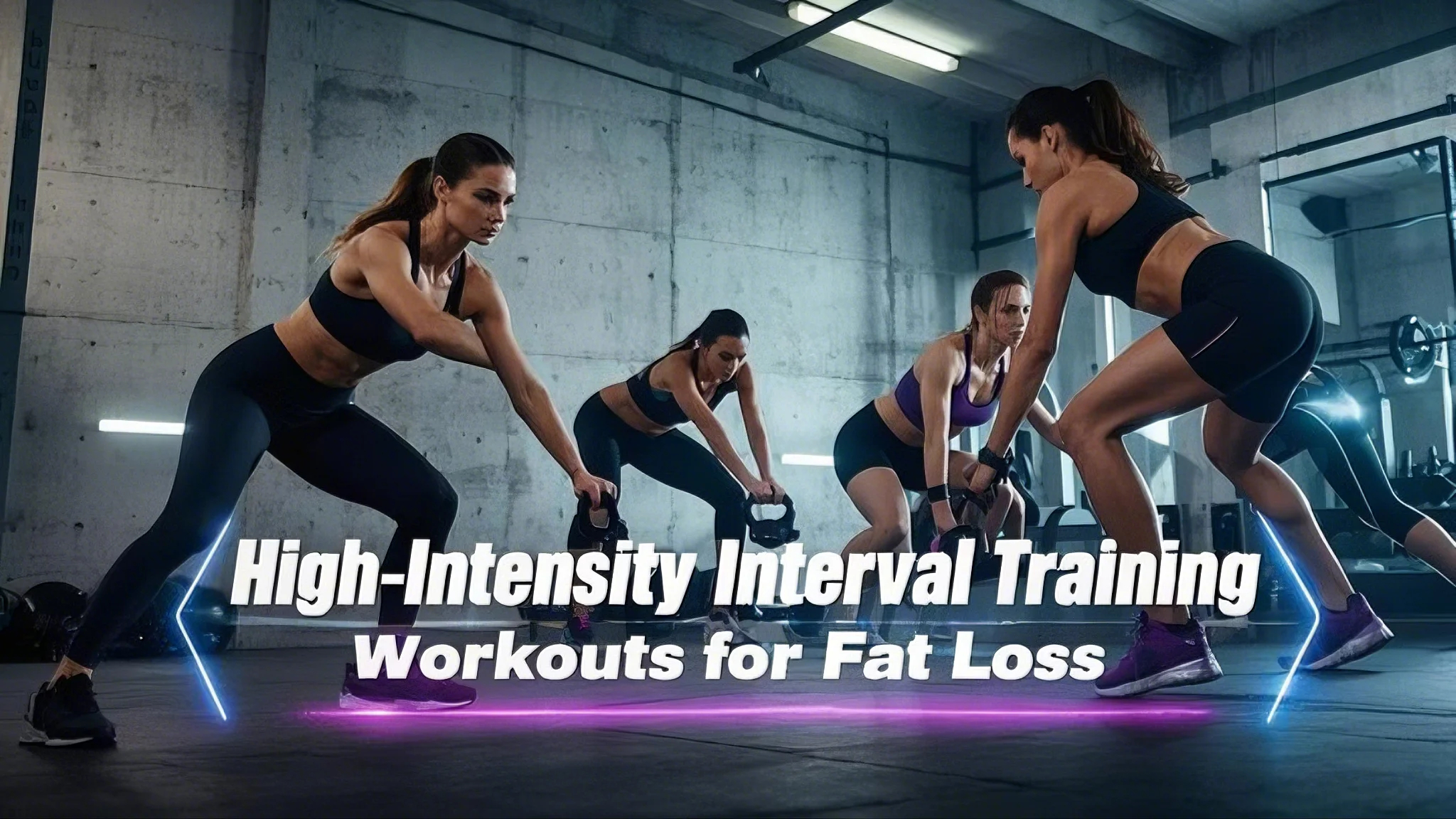HIIT Workouts (High-Intensity Interval Training) for Fat Loss
Did you know that a 20-minute HIIT workout can burn the same number of calories as a 40- to 60-minute steady-state cardio session? That’s right—High-Intensity Interval Training (HIIT) is not just a fitness trend; it’s a proven strategy for fat loss and overall health. By alternating short bursts of intense exercise with brief rest periods, HIIT maximizes calorie burn and boosts your metabolism for hours after your workout.
Whether you’re a beginner or a seasoned fitness enthusiast, HIIT offers something for everyone. From bodyweight exercises like squats and lunges to equipment-based routines, this training style is versatile and time-efficient. Plus, it’s designed to improve endurance, build strength, and enhance cardiovascular health—all in a fraction of the time of traditional workouts.
Ready to learn more? This article will guide you through the benefits of HIIT, safety tips, and workout ideas tailored to your fitness level. Discover how to make the most of your time and achieve your fat loss goals with this powerful training method. For more inspiration, check out these top HIIT cardio workouts for weight.
What Are HIIT Workouts and Their Role in Fat Loss?
High-Intensity Interval Training (HIIT) is more than just a fitness buzzword. It’s a game-changer for those looking to burn fat and boost their metabolism. Unlike traditional steady-state cardio, HIIT alternates short bursts of intense exercise with brief rest periods. This approach maximizes calorie burn and keeps your body working long after the workout ends.
Definition and Core Principles
HIIT is all about intensity and efficiency. A typical session might include 30 seconds of sprinting followed by 30 seconds of walking, repeated for 15-20 minutes. This interval training method challenges your heart, muscles, and endurance in a fraction of the time of traditional routines. Whether you’re doing squats, planks, or push-ups, the goal is to push your limits during the active intervals.
How HIIT Boosts Metabolism
One of the biggest benefits of HIIT is its ability to create an “afterburn” effect, scientifically known as EPOC (Excess Post-Exercise Oxygen Consumption). After a HIIT workout, your body continues to burn calories as it works to restore oxygen levels and repair muscles. Studies show that this metabolic boost can last for hours, making HIIT a powerful tool for fat loss.
For example, a 20-minute HIIT session can burn more calories than a 40-minute jog. Plus, it’s adaptable for all fitness levels. Beginners can start with modified moves like knee push-ups or slow squats, while advanced exercisers can amp up the intensity with burpees or mountain climbers.
| Workout Type | Duration | Calories Burned |
|---|---|---|
| HIIT | 20 minutes | 200-300 |
| Steady-State Cardio | 40 minutes | 150-250 |
Ready to give it a try? Check out these HIIT workouts for weight loss to get started. Whether you’re a beginner or a seasoned athlete, HIIT offers a time-efficient way to achieve your fitness goals.
The Science and Benefits of HIIT for Weight Loss
Ever wondered why HIIT is so effective for weight loss? The secret lies in its ability to burn calories long after your workout ends. This is thanks to a process called EPOC (Excess Post-Exercise Oxygen Consumption). After a HIIT session, your body works overtime to restore oxygen levels and repair muscles, keeping your metabolism fired up for hours.
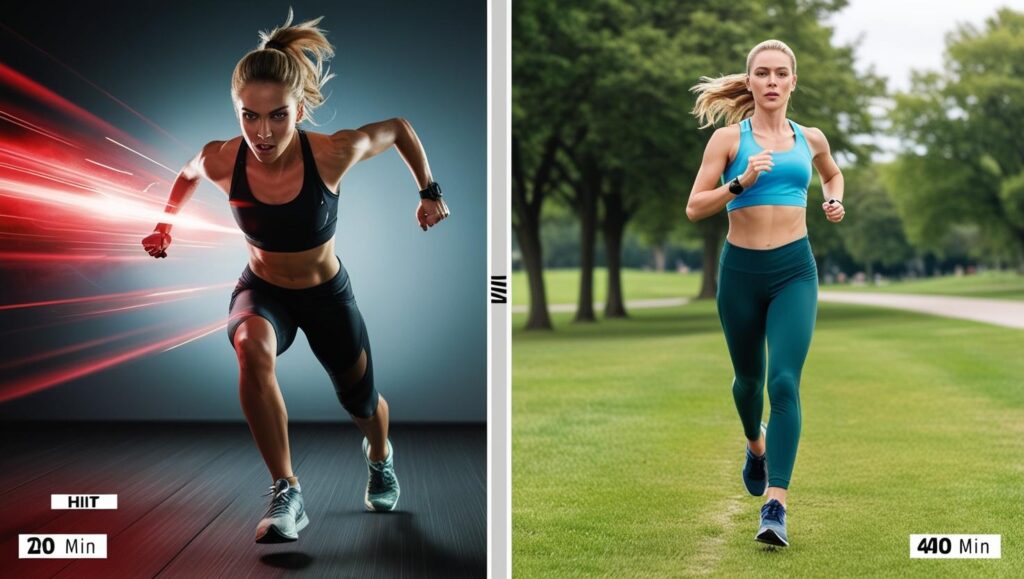
EPOC and Extended Calorie Burn
EPOC is the scientific term for the “afterburn” effect. During a HIIT workout, your body uses more oxygen than usual. Afterward, it needs extra time to recover, which means you’re burning calories even while resting. Studies show that a 20-minute HIIT session can burn more calories than a 40-minute jog. This makes it a time-efficient way to achieve your weight loss goals.
For example, exercises like squats, planks, and mountain climbers push your heart rate to its peak. This intensity triggers EPOC, ensuring your body continues to burn calories long after you’ve finished. It’s like getting a bonus workout without lifting a finger.
Fat Reduction and Muscle Preservation
One of the biggest benefits of HIIT is its ability to target fat while preserving muscle. Traditional cardio can sometimes lead to muscle loss, but HIIT focuses on maintaining lean mass. This is because the short, intense bursts of exercise stimulate muscle fibers, promoting strength and endurance.
Research shows that HIIT reduces body fat more effectively than steady-state cardio. For instance, a study found that participants who did interval training lost more fat than those who stuck to traditional workouts. Plus, the variety of movements—like squats, lunges, and push-ups—keeps your routine fresh and engaging.
Ready to experience these benefits for yourself? Start with a simple HIIT routine and watch your body transform. Whether you’re aiming to shed fat or build strength, HIIT offers a science-backed solution that delivers results.
Beginner HIIT Workouts: Simple Routines to Get Started
Starting a new fitness routine can feel overwhelming, but HIIT makes it simple and effective. With just a few bodyweight exercises, you can kickstart your journey toward better health and fat loss. The best part? You don’t need any equipment to get started.
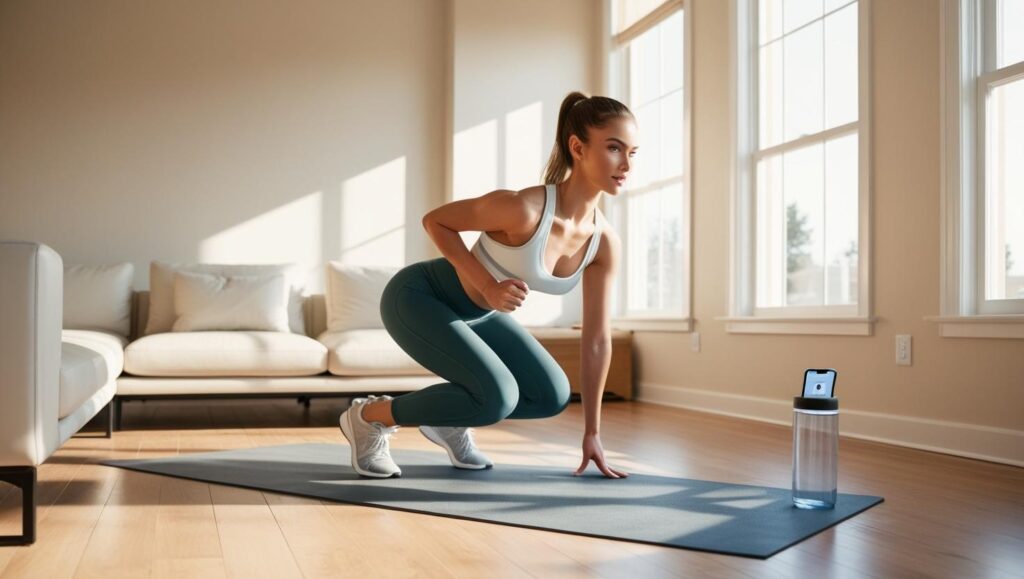
Accessible Bodyweight Exercises
Beginner-friendly HIIT workouts focus on simple moves that anyone can do. Start with exercises like squats, jumping jacks, and planks. These movements target multiple muscle groups and get your heart pumping without requiring fancy gear.
For example, a basic squat works your legs, core, and glutes. Pair it with a jumping jack for a full-body workout. These exercises are easy to modify, so you can adjust the intensity as you build strength.
Structuring Your First Sessions
When starting HIIT, it’s important to keep things simple. Begin with 2-3 sessions per week, each lasting 20 to 30 minutes. A good structure is 30 seconds of high intensity followed by 1 minute of rest. This ratio allows your body to recover while keeping the workout effective.
Always include a 5-minute warm-up and cool-down to prevent injuries. Start with moves like arm circles or light jogging to get your blood flowing. After your session, stretch your muscles to improve flexibility and reduce soreness.
| Exercise | Duration | Rest |
|---|---|---|
| Squats | 30 seconds | 1 minute |
| Jumping Jacks | 30 seconds | 1 minute |
| Plank | 30 seconds | 1 minute |
Remember, consistency is key. Even a short HIIT workout can deliver big results. Start slow, listen to your body, and gradually increase the intensity as you get stronger.
Elevating Your Routine with Intermediate and Advanced HIIT
Ready to take your fitness game to the next level? If you’ve mastered the basics, it’s time to crank up the intensity with intermediate and advanced HIIT workouts. These routines challenge your endurance, strength, and coordination while keeping your workout exciting and effective.

Challenging Variations: Mountain Climbers and Kettlebell Swings
Intermediate HIIT introduces moves like mountain climbers and kettlebell swings. Mountain climbers target your core, shoulders, and legs. Start in a plank position, then alternate driving your knees toward your chest as fast as possible for 30 seconds.
Kettlebell swings are a full-body exercise that builds strength and power. Hold the kettlebell with both hands, hinge at your hips, and swing it to shoulder height. Keep your core engaged and your movements controlled.
Exploring Advanced Moves: Clapping Push-Ups and Burpee Box Jumps
For advanced HIIT, try clapping push-ups and burpee box jumps. Clapping push-ups add explosive power to your arm and chest muscles. Lower yourself into a push-up, then push off the ground with enough force to clap your hands before landing.
Burpee box jumps combine cardio and strength. Start in a standing position, drop into a burpee, then jump onto a sturdy box. This move targets your legs, core, and cardiovascular system.
| Exercise | Duration | Rest |
|---|---|---|
| Mountain Climbers | 40 seconds | 20 seconds |
| Kettlebell Swings | 40 seconds | 20 seconds |
| Clapping Push-Ups | 45 seconds | 15 seconds |
| Burpee Box Jumps | 45 seconds | 15 seconds |
Remember, mastering basic movements is key before tackling advanced variations. Gradually increase intensity and track your progress. For more tips on HIIT, check out this comprehensive guide to high-intensity interval training.
Mastering hiit-workouts: Tips, Techniques, and Safety Guidelines
Want to make the most of your HIIT workouts while staying safe and injury-free? The key lies in proper preparation, recovery, and listening to your body. By following these guidelines, you can push your limits without risking harm.
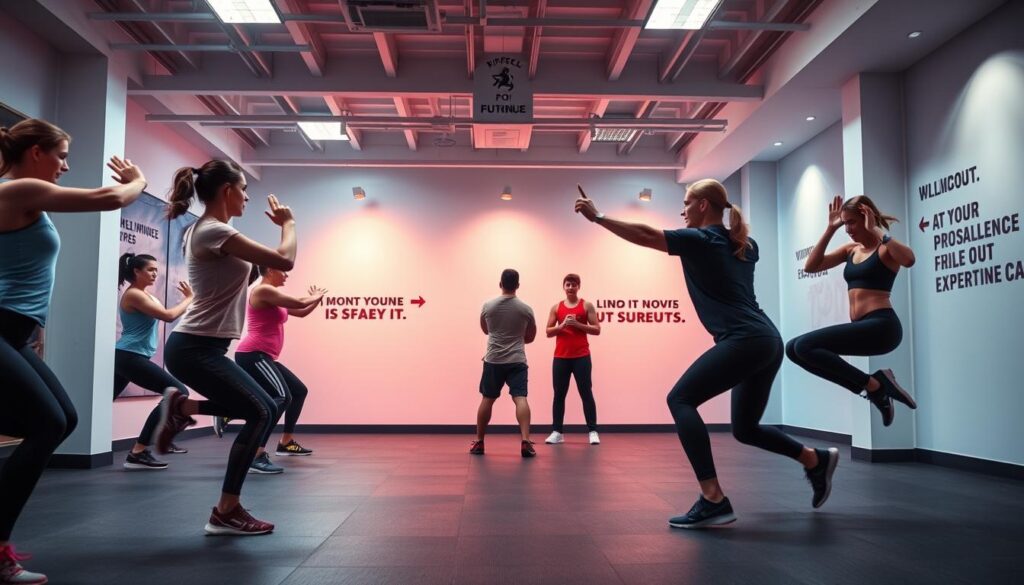
Dynamic Warm-Ups and Thorough Cool-Downs
A dynamic warm-up is essential before diving into high-intensity intervals. It prepares your muscles, increases blood flow, and reduces the risk of injury. Start with 5-10 minutes of light cardio, like jogging or jumping jacks, followed by dynamic stretches such as leg swings or arm circles.
After your workout, don’t skip the cool-down. Gradually lower your heart rate with 5-10 minutes of light activity, like walking or stretching. This helps prevent muscle soreness and improves flexibility.
Listening to Your Body and Preventing Injury
Your body sends signals during and after exercise. Pay attention to pain, fatigue, or discomfort. If something doesn’t feel right, modify the exercise or take a break. For example, if a squat hurts your knees, try a modified version or switch to a different move.
Common signs of overexertion include dizziness, extreme fatigue, or sharp pain. If you experience these, stop immediately and rest. Hydration and proper form are also crucial for injury prevention.
| Warm-Up | Duration | Cool-Down | Duration |
|---|---|---|---|
| Light Jogging | 3 minutes | Walking | 5 minutes |
| Leg Swings | 1 minute | Hamstring Stretch | 1 minute |
| Arm Circles | 1 minute | Quad Stretch | 1 minute |
Remember, safety is just as important as intensity. By warming up, cooling down, and listening to your body, you can enjoy the benefits of HIIT without the risks.
Quick HIIT Workout Variations for Busy Lifestyles
Short on time but still want to crush your fitness goals? HIIT workouts are here to save the day. These quick, intense sessions are perfect for squeezing into a packed schedule. Whether you have 15 minutes or 20, you can get a full-body burn without stepping foot in a gym.
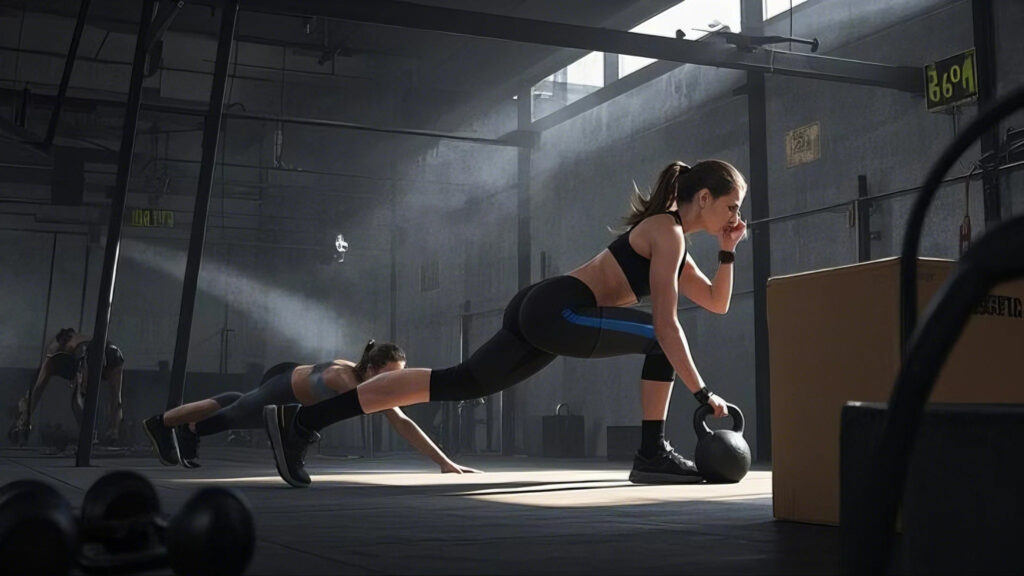
15- to 20-Minute Equipment-Free Routines
No equipment? No problem. A 15-minute bodyweight HIIT workout can torch calories and build strength. Start with moves like squats, jumping jacks, and planks. These exercises target multiple muscle groups and get your heart pumping fast.
For a 20-minute session, try alternating 30 seconds of high-intensity exercise with 30 seconds of rest. This keeps your heart rate up while giving your body brief recovery periods. It’s efficient, effective, and fits into even the busiest days.
Tabata, AMRAP, and Dumbbell Options
If you’re ready to mix things up, try Tabata or AMRAP formats. Tabata involves 20 seconds of all-out effort followed by 10 seconds of rest, repeated for 4 minutes. AMRAP (As Many Rounds As Possible) challenges you to complete as many rounds of a circuit as you can in a set time.
For those with dumbbells, a 20-minute dumbbell HIIT workout can add extra resistance. Moves like kettlebell swings and dumbbell thrusters build strength while keeping your heart rate high. These formats are perfect for adding variety to your routine.
Designing Short, Intense Sessions
When time is tight, every second counts. Start with a quick 2-minute warm-up to get your blood flowing. Then, dive into high-intensity intervals like mountain climbers or burpees. Finish with a 2-minute cool-down to stretch and recover.
Here’s a sample 15-minute HIIT routine to get you started:
| Exercise | Duration | Rest |
|---|---|---|
| Squats | 30 seconds | 30 seconds |
| Push-Ups | 30 seconds | 30 seconds |
| Mountain Climbers | 30 seconds | 30 seconds |
| Plank | 30 seconds | 30 seconds |
Remember, consistency is key. Even a short HIIT workout can deliver big results. Start slow, listen to your body, and gradually increase the intensity as you get stronger.
Integrating HIIT into Your Weight Loss Journey with Expert Strategies
Looking to maximize your weight loss results with HIIT? Here’s how to do it right. Combining intense workouts with smart strategies can make all the difference. From nutrition to tracking progress, these expert tips will help you stay on track and see real results.
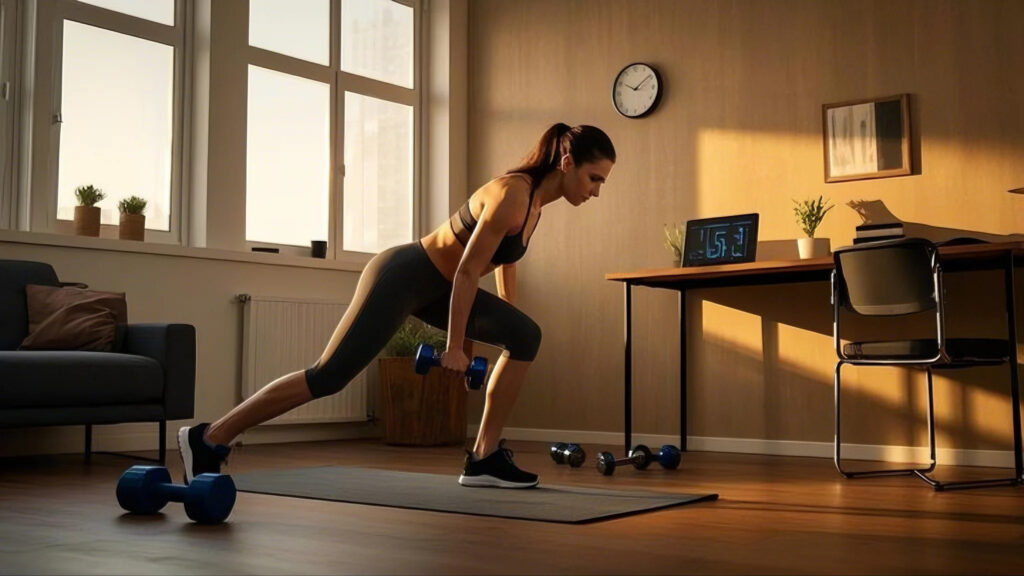
Nutritional Support and Recovery Tips
Pairing HIIT with the right nutrition is a game-changer. Focus on balanced meals that include lean proteins, healthy fats, and complex carbs. These fuel your body for intense exercise and aid in recovery.
Hydration is also key. Drink plenty of water before, during, and after your workout. Post-session, opt for snacks like a banana with almond butter or a protein shake to replenish energy and repair muscles.
Don’t forget rest days. Your body needs time to recover after high-intensity sessions. Aim for 1-2 rest days per week to avoid burnout and injuries.
Staying Consistent and Tracking Your Progress
Consistency is the secret to long-term success. Set realistic goals and stick to a regular routine. Whether it’s 3 sessions a week or 20 minutes a day, small steps lead to big changes.
Track your progress to stay motivated. Use a workout log or fitness app to record your sessions, noting improvements in strength, endurance, or weight loss. Seeing your progress on paper can be incredibly rewarding.
Remember, it’s not just about the scale. Pay attention to how you feel, how your clothes fit, and your overall energy levels. These are all signs of success.
- Pair HIIT with balanced meals for optimal results.
- Stay hydrated and refuel with post-workout snacks.
- Take rest days to let your body recover.
- Track progress with logs or apps to stay motivated.
By integrating these expert strategies, you’ll make HIIT not just effective but sustainable. Start today and watch your weight loss journey transform!
Wrapping Up Your HIIT Journey: Motivation and Long-Term Success
Let’s wrap up your HIIT journey with tips for lasting success. HIIT isn’t just a quick fix—it’s a powerful tool for fat loss, endurance, and overall health. Studies show that just three 20-minute sessions a week can lead to significant results, like reduced body fat and improved cardiovascular health.
Staying motivated is key. Set realistic goals, track your progress, and celebrate small wins. Whether it’s adding an extra minute to your workout or mastering a new move, every step counts. Remember, consistency beats intensity in the long run.
View HIIT as a lifestyle, not a temporary challenge. Pair it with balanced nutrition, proper hydration, and adequate rest to avoid burnout. Listen to your body and adjust your routine as needed.
Finally, keep it fun! Mix up your workouts with different exercises or formats like Tabata or AMRAP. With the right mindset and strategies, HIIT can become a sustainable part of your healthy lifestyle. Keep moving forward—you’ve got this!
